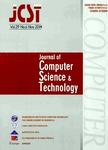Level-of-Detail Rendering of Large-Scale Irregular Volume Datasets Using Particles
Level-of-Detail Rendering of Large-Scale Irregular Volume Datasets Using Particles作者机构:Graduate School of Engineering Kyoto University Kyoto 6068501 Japan Center for the Promotion of Excellence in Higher Education Kyoto University Kyoto 6068501 Japan
出 版 物:《Journal of Computer Science & Technology》 (计算机科学技术学报(英文版))
年 卷 期:2010年第25卷第5期
页 面:905-915页
核心收录:
学科分类:08[工学] 080203[工学-机械设计及理论] 0802[工学-机械工程]
主 题:large-scale irregular volume level-of-detail volume rendering of unstructured meshes
摘 要:This paper describes a level-of-detail rendering technique for large-scale irregular volume *** is well known that the memory bandwidth consumed by visibility sorting becomes the limiting factor when carrying out volume rendering of such *** develop a sorting-free volume rendering technique,we previously proposed a particle-based technique that generates opaque and emissive particles using a density function constant within an irregular volume cell and projects the particles onto an image plane with *** the density function changes significantly in an irregular volume cell,the cell boundary may become prominent,which can cause blocky *** the number of the sub-pixels increases,the required frame buffer tends to be *** solve this problem,this work proposes a new particle-based volume rendering which generates particles using metropolis sampling and renders the particles using the ensemble average. To confirm the effectiveness of this method,we applied our proposed technique to several irregular volume datasets,with the result that the ensemble average outperforms the sub-pixel average in computational complexity and memory usage. In addition,the ensemble average technique allowed us to implement a level of detail in the interactive rendering of a 71-million-cell hexahedral volume dataset and a 26-million-cell quadratic tetrahedral volume dataset.



